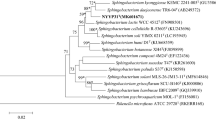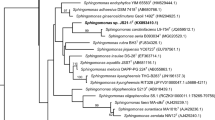Abstract
The taxonomic status of a bacterium, strain NCCP-246T, isolated from rhizosphere of Vigna mungo, was determined using a polyphasic taxonomic approach. The strain NCCP-246T can grow at 16–37 °C (optimum 32 °C), at pH ranges of 6–8 (optimum growth occurs at pH 7) and in 0–4 % (w/v) NaCl. Phylogenetic analysis based upon on 16S rRNA gene sequence comparison revealed that strain NCCP-246T belonged to genus Sphingobacterium. Strain NCCP-246T showed highest similarity to the type strain of Sphingobacterium canadense CR11T (97.67 %) and less than 97 % with other species of the genus. The DNA–DNA relatedness value of strain NCCP-246T with S. canadense CR11T and Sphingobacterium thalpophilum JCM 21153T was 55 and 44.4 %, respectively. The chemotaxonomic data revealed the major menaquinone as MK-7 and dominant cellular fatty acids were summed feature 3 [C16:1 ω7c/C16:1 ω6c] (37.07 %), iso-C15:0 (28.03 %), C16:0 (11.85 %), C17:0 cyclo (8.84 %) and C14:0 (2.42 %). The G+C content of the strain was 39.2 mol%. On the basis of DNA–DNA hybridization, phylogenetic analyses, physiological and, biochemical data, strain NCCP-246T can be differentiated from the validly named members of genus Sphingobacterium and thus represents as a new species, for which the name, Sphingobacterium pakistanensis sp. nov. is proposed with the type strain NCCP-246T (= JCM18974 T = KCTC 23914T).

Similar content being viewed by others
References
Ahmed I, Yokota A, Fujiwara T (2007) A novel highly boron tolerant bacterium, Bacillus boroniphilus sp. nov., isolated from soil, that requires boron for its growth. Extremophiles 11:217–224
Albert RA, Waas NE, Pavlons SC, Pearson JL, Ketelboeter L, Rosselló-Móra R, Busse H-J (2013) Sphingobacterium psychroaquaticum sp. nov., a psychrophilic bacterium isolated from Lake Michigan water. Int J Syst Evol Microbiol 63(3):952–958. doi:10.1099/ijs.0.043844-0
Bric JM, Bostock RM, Silverstone SE (1991) Rapid in situ assay for indoleacetic acid production by bacteria immobilized on a nitrocellulose membrane. Appl Environ Microbiol 57(2):535–538
Duan S, Liu Z, Feng X, Zheng K, Cheng L (2009) Sphingobacterium bambusae sp. nov., isolated from soil of bamboo plantation. J Microbiol 47(6):693–698. doi:10.1007/s12275-009-0296-2
Ezaki T, Hashimoto Y, Yabuuchi E (1989) Fluorometric deoxyribonucleic acid-deoxyribonucleic acid hybridization in microdilution wells as an alternative to membrane filter hybridization in which radioisotopes are used to determine genetic relatedness among bacterial strains. Int J Syst Bacteriol 39(3):224–229. doi:10.1099/00207713-39-3-224
Felsenstein J (2005) PHYLIP (Phylogeny Inference Package). Version 3.6. distributed by the author. Seattle, Washington, Department of Genome Sciences, University of Washington
Hayat R, Sheirdil RA, Iftikhar-ul-Hassan M, Ahmed I (2013) Characterization and identification of compost bacteria based on 16S rRNA gene sequencing. Ann Microbiol 63(3):905–912. doi:10.1007/s13213-012-0542-4
He X, Xiao T, Kuang H, Lan X, Tudahong M, Osman G, Fang C, Rahman E (2010) Sphingobacterium shayense sp. nov., isolated from forest soil. Int J Syst Evol Microbiol 60(Pt 10):2377–2381. doi:10.1099/ijs.0.018481-0
Jung MY, Kim J-S, Paek WK, Styrak I, Park I-S, Sin Y, Paek J, Park KA, Kim H, Kim HL, Chang Y-H (2012) Description of Lysinibacillus sinduriensis sp. nov., and transfer of Bacillus massiliensis and Bacillus odysseyi to the genus Lysinibacillus as Lysinibacillus massiliensis comb. nov. and Lysinibacillus odysseyi comb. nov. with emended description of the genus Lysinibacillus. Int J Syst Evol Microbiol 62(10):2347–2355. doi:10.1099/ijs.0.033837-0
Kim K-H, Ten LN, Liu Q-M, Im W-T, Lee S-T (2006) Sphingobacterium daejeonense sp. nov., isolated from a compost sample. Int J Syst Evol Microbiol 56(9):2031–2036. doi:10.1099/ijs.0.64406-0
Lee D-H, Hur JS, Kahng H-Y (2013) Sphingobacterium cladoniae sp. nov., isolated from lichen, Cladonia sp., and emended description of Sphingobacterium siyangense. Int J Syst Evol Microbiol 63(2):755–760. doi:10.1099/ijs.0.038844-0
Liu R, Liu H, Zhang CX, Yang SY, Liu XH, Zhang KY, Lai R (2008) Sphingobacterium siyangense sp. nov., isolated from farm soil. Int J Syst Evol Microbiol 58(6):1458–1462. doi:10.1099/ijs.0.65696-0
Marques AM, Burgos-Diaz C, Aranda FJ, Teruel JA, Manresa A, Ortiz A, Farfan M (2012) Sphingobacterium detergens sp. nov., a surfactant-producing bacterium isolated from soil. Int J Syst Evol Microbiol 62(12):3036–3041. doi:10.1099/ijs.0.036707-0
Marqués AM, Burgos-Díaz C, Aranda FJ, Teruel JA, Manresa À, Ortiz A, Farfán M (2012) Sphingobacterium detergens sp. nov., a surfactant-producing bacterium isolated from soil. Int J Syst Evol Microbiol 62(12):3036–3041. doi:10.1099/ijs.0.036707-0
Mehnaz S, Weselowski B, Lazarovits G (2007) Sphingobacterium canadense sp. nov., an isolate from corn roots. Syst Appl Microbiol 30(7):519–524. doi:10.1016/j.syapm.2007.06.002
Minnikin DE, O’Donnell AG, Goodfellow M, Alderson G, Athalye M, Schaal A, Parlett JH (1984) An integrated procedure for the extraction of bacterial isoprenoid quinones and polar lipids. J Microbiol Method 2:233–241
Poly F, Ranjard L, Nazaret S, Gourbière F, Monrozier LJ (2001) Comparison of nifH gene pools in soils and soil microenvironments with contrasting properties. Appl Environ Microbiol 67(5):2255–2262. doi:10.1128/aem.67.5.2255- 2262.2001
Roohi A, Ahmed I, Iqbal M, Jamil M (2012) Preliminary isolation and characterization of halotolerant and halophilic bacteria from salt mines of Karak. Pakistan. Pak J Bot 44(SI 1):365–370
Sasser M (1990) Identification of bacteria by gas chromatography of cellular fatty acids: MIDI technical note 101. MIDI, Newark
Schmidt VS, Wenning M, Scherer S (2012) Sphingobacterium lactis sp. nov. and Sphingobacterium alimentarium sp. nov., isolated from raw milk and a dairy environment. Int J Syst Evol Microbiol 62(7):1506–1511. doi:10.1099/ijs.0.036327-0
Shivaji S, Ray MK, Shyamala Rao N, Saisree L, Jagannadham MV, Seshu Kumar G, Reddy GSN, Bhargava PM (1992) Sphingobacterium antarcticus sp. nov., a psychrotrophic bacterium from the soils of Schirmacher Oasis, Antarctica. Int J Syst Bacteriol 42(1):102–106. doi:10.1099/00207713-42-1-102
Stackebrandt E, Goebel BM (1994) Taxonomic note: a place for DNA–DNA reassociation and 16S rRNA sequence analysis in the present species definition in bacteriology. Int J Syst Evol Microbiol 44(4):846–849. doi:10.1099/00207713-44-4-846
Steyn PL, Segers P, Vancanneyt M, Sandra P, Kersters K, Joubert JJ (1998) Classification of heparinolytic bacteria into a new genus, Pedobacter, comprising four species: Pedobacter heparinus comb. nov., Pedobacter piscium comb. nov., Pedobacter africanus sp. nov. and Pedobacter saltans sp. nov. proposal of the family Sphingobacteriaceae fam. nov. Int J Syst Bacteriol 48(1):165–177. doi:10.1099/00207713-48-1-165
Sun L-N, Zhang J, Chen Q, He J, Li S-P (2013) Sphingobacterium caeni sp. nov., isolated from activated sludge. Int J Syst Evol Microbiol 63(6):2260–2264. doi:10.1099/ijs.0.046987-0
Takeuchi M, Yokota A (1992) Proposals of Sphingobacterium faecium sp. nov., Sphingobacterium piscium sp. nov., Sphingobacterium heparinum comb. nov., Sphingobacterium thalpophilum comb. nov., and two genospecies of the genus Sphingobacterium and synonymy of Flavobacterium yabuuchiae and Sphingobacterium spiritivorum. J Gen Appl Microbiol 38:465–482
Watanabe FS, Olsen SR (1965) Test of an ascorbic acid method for determining phosphorus in water and extracts from soil. Soil Sci Soc Am J 29(6):677–678. doi:10.2136/sssaj1965.03615995002900060025x
Yabuuchi E, Kanek T, Yan I, Moss CW, Miyosh N (1983) Sphingobacterium gen. nov., Sphingobacterium spiritivorum comb. nov., Sphingobacterium multivorum comb. nov., Sphingobacterium mizutae sp. nov., and Flavobacterium indologenes sp. nov.: glucose-nonfermenting gram-negative rods in CDC groups IIK-2 and IIb. Int J Syst Bacteriol 33(3):580–598
Yoo S-H, Weon H-Y, Jang H-B, Kim B-Y, Kwon S-W, Go S-J, Stackebrandt E (2007) Sphingobacterium composti sp. nov., isolated from cotton-waste composts. Int J Syst Evol Microbiol 57(7):1590–1593. doi:10.1099/ijs.0.64948-0
Acknowledgments
We are thankful to Professor Dr. George Lazarovits from Southern Crop Protection and Food Research Centre, Canada and Dr. Moriya Ohkuma from Japan Collection of Microorganisms (JCM), Riken BioResource Centre, Tsukuba, Japan for providing the reference strains (Sphingobacterium canadense CR11T and S. thalpophilum JCM 21153T, respectively) for these experiments. This work was partially supported by PSDP Project “Research for Agricultural Development Program (RADP)” funded by Pakistan Agricultural Research Council (PARC). The partial financial support of KRIBB to the author “Muhammad Ehsan” in the training course at Korean Collection for Type Cultures, Biological Resources Centre, KRIBB under the umbrella of ACM forum is also gratefully acknowledged.
Author information
Authors and Affiliations
Corresponding authors
Additional information
Iftikhar Ahmed and Muhammad Ehsan have contributed equally in the experiments.
The DDBJ/EMBL/GenBank accession number for the 16S rRNA gene sequence of strain NCCP-246T (=JCM18974T = KCTC 23914T), is AB610802.
Electronic supplementary material
Below is the link to the electronic supplementary material.
Rights and permissions
About this article
Cite this article
Ahmed, I., Ehsan, M., Sin, Y. et al. Sphingobacterium pakistanensis sp. nov., a novel plant growth promoting rhizobacteria isolated from rhizosphere of Vigna mungo . Antonie van Leeuwenhoek 105, 325–333 (2014). https://doi.org/10.1007/s10482-013-0077-0
Received:
Accepted:
Published:
Issue Date:
DOI: https://doi.org/10.1007/s10482-013-0077-0




